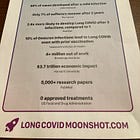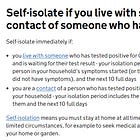Well, it’s been another year on Substack1. Despite being busier in real life than I’ve ever been, this is my 36th piece of the year (so one every ten days or so), and I’ve gained just over a thousand readers in that time. That’s not too bad, I think.
So, it’s probably a good time to reflect, to be lazy and do the equivalent of the TV clip show episode, if only to remind myself of a few of the pieces I wrote in the last year.
I think maybe my favourite post of the year is this one about Long COVID:
It’s not a cheerful subject, and I think it’s let down by wrong-headed coverage on both extremes. So I think a data-driven post
arguing that a) Long COVID isn’t anything like the problem it was b) long haulers have been let down c) no, it’s not a way of hiding vaccine injuries
is a contribution to the debate that I’m still proud of.
Pretty topically, with the US election coming up, I think my early September take on polling models has stood the test of time.
Specifically, the argument that obsessing about small model shifts is pointless still holds good I think, as well as sticking my neck out to say:
if things change, and Silver’s model moves out to 70-30 again in either direction, then I’d like to know about it. But my suspicion is that it’s extremely likely that won’t happen, and that we’re locked into a death spiral of “too close to call” for the next two months
wasn’t too bad a summary of how it all ended up going.
Back on the COVID beat, when there was lots of excitement about the JN.1 wave in the run up to last Christmas, I wrote this piece arguing that we should be OK.
I’d called the incoming wave a few weeks earlier, so while some commentators were telling us that the wave wouldn’t peak until mid-January and might be the largest ever, it was gratifying that my conclusion that the key factor was mixing and that
We shouldn’t extrapolate admissions trends into January based on the behaviour of JN.1 in party season
worked out fine. (Annoyingly, it’s one of those takes that was obvious in retrospect but ignored by too many people at the time).
It’s not all been COVID though, and indeed I’ve deliberately tried to pivot away from that lately. It was an election year in the UK, and I had a bit of a rant about various aspects of it, including Reform’s dodgy stats on vaccine safety. But in particular, I’ve got interested in aspects of the energy transition
because I felt that
as mathematicians would say, having large installed capacity is a necessary but not a sufficient condition to guarantee energy supply without blackouts. You need to think about how the energy is spread across the year, and I’m not sure enough journalists are doing that.
To be honest, I’m still not convinced that these issues of intermittency and storage are enough on the media and public’s radar. I guess we’ll have to see if they break through in the next year.
Out in the real world, I gave various public lectures and general audience talks earlier in the year (I’m trying to keep this up a little bit despite my new job, but it’s harder). In March I reflected on the fact that a talk I gave went viral on social media
thanks to the use of what some people call a “Malcolm”:
definitely I think it’s worth considering the use of Malcolms when you try to communicate with a general audience. Obviously they need to be based on something - you can’t just lie! And perhaps if I’d known that the example would be seen by 6 million people I might have had second thoughts (I’d certainly have tried to “um” and “ah” less in speaking, and tried to make my shirt look less crumpled!).
The piece talks more about the difference between academic writing and writing for a general audience, as well as powers of 2.
But I really started Substacking to have a new home for my COVID tweets away from Twitter, and I think the most important post of the year is still this one
about the way that scientists should respond to mistakes in their work. This is in the light of my ongoing strong suspicion that
Independent SAGE's May 2020 Report on Schools overestimated the chances of a child being infected in the classroom, conservatively by a factor of 30, perhaps much higher.
It’s still the case that nobody from ISAGE has ever got back to me about this despite my best efforts, so if you see them around do ask them about it! But if necessary, I guess we’ll have to wait for the Public Inquiry to reach Module 8 (on children and young people) in Autumn 2025.
Anyway, that was my year on Substack. I’ve enjoyed writing the pieces, and still find producing 800-2000 words on a topic of my choosing to be a therapeutic exercise. But if you enjoy reading them, then even better - so thanks for reading this far, and I’ll see what I can do to keep up a similar rate of pieces in my third year on this place!
Strictly speaking, my anniversary is Tuesday 5th, but close enough.









Please keep them coming. One of my favourite Substack follows and just about to start Numbercrunch 👍
On a still, gray day last week I worked out how much installed spare capacity we have in EV batteries. It’s still not the answer!